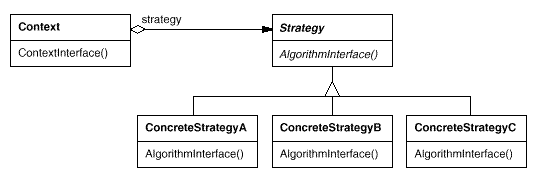- Aka: Policy
- Intent: Define a family of algorithms, encapsulate each one and make them interchangeable. It lets the algorithm vary independently from clients that use it.
Structure §

Image from: Gamma, Helm, Johnson, and Vissides
Applicability §
- Many related classes differ only in their behavior.
- You need different variants of an algorithm
- An algorithm uses data that clients shouldn’t know about.
- A class defines many behaviors and these appear as many conditional statements.
Consequences §
- Defines a family of algorithms for contexts to reuse. Inheritance can factor out common functionalities.
- An alternative to subclassing, especially for classes differing only in behavior
- Eliminates conditional statements.
- Provides a choice of implementations for the same behavior
- Clients must be aware of different Strategies before it can select the appropriate one.
- Communication overhead between strategy and context.
- Increased number of objects.
Implementation §
- Use only when the variation is behavior irrelevant to clients.
Defining Strategy and Context interfaces. §
- The strategy and context must provide each other efficient access to needed data:
- Have context pass data in parameters (decouples Strategy and context, but context might pass unneeded data).
- Store a reference to context in Strategy (or have context pass itself as parameter) (tightly couples Strategy and context, but strategy can request exactly what it needs)
- Strategies as template parameters if: the Strategy can be selected at compile-time and it doesn’t have to be changed at run time.
Optional Strategy Objects §
- Remove strategy objects in contexts if they aren’t needed or If default behaviors are sufficient.
